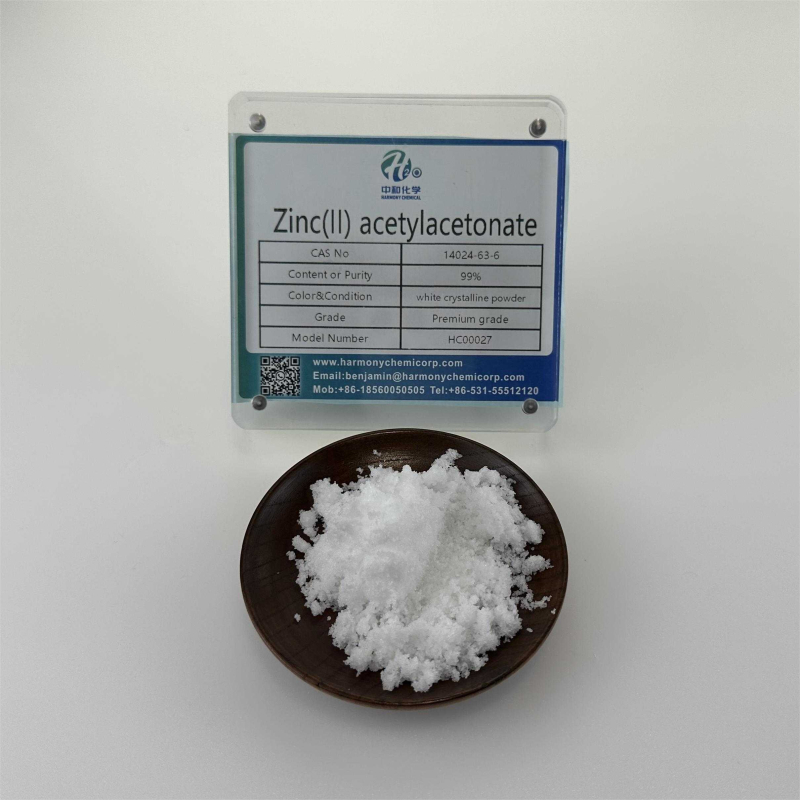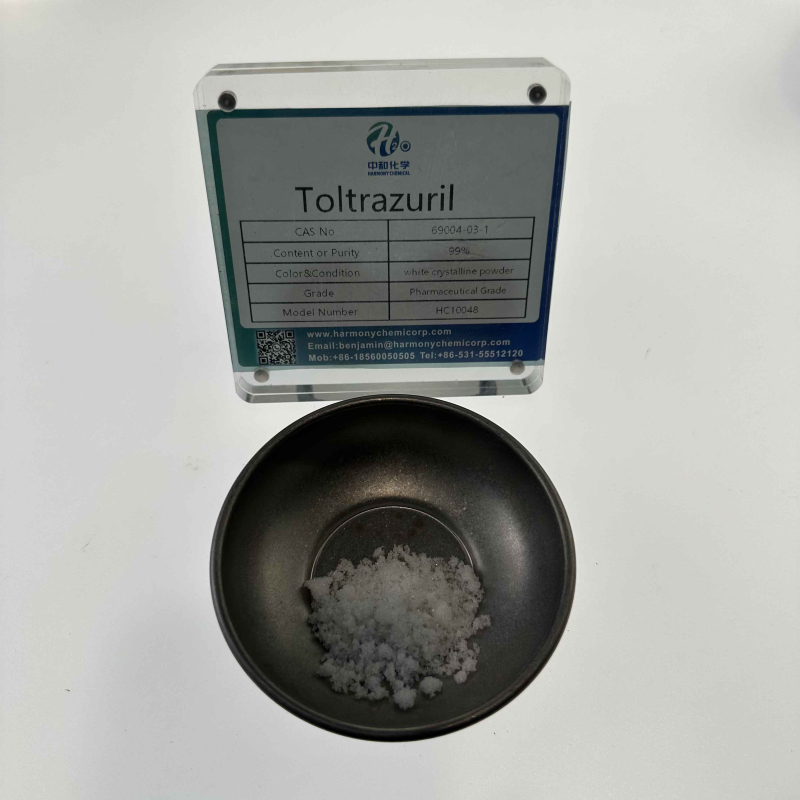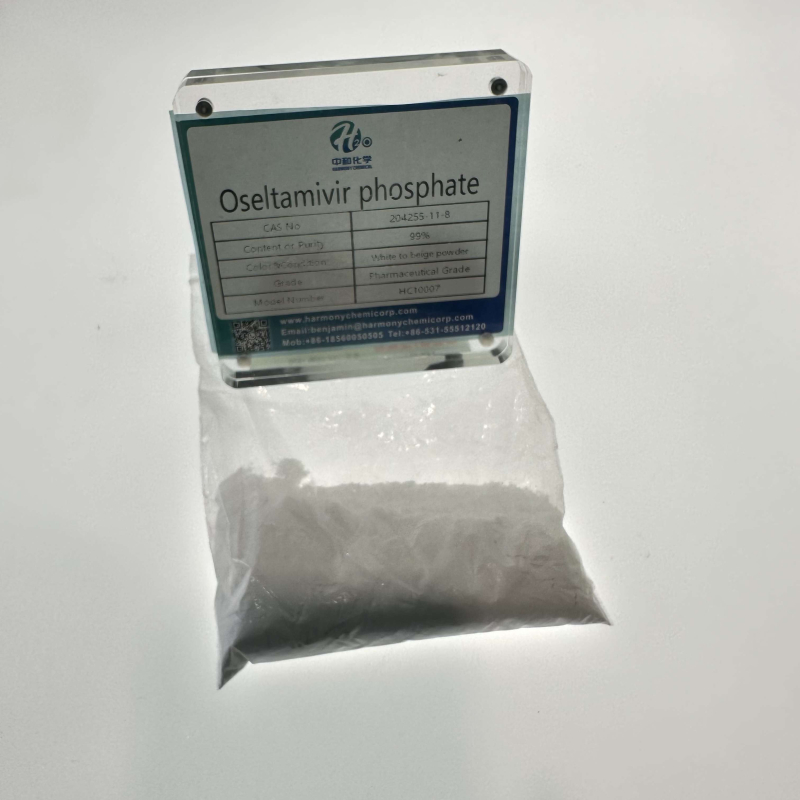Physicochemical properties: Acetylacetone zinc is a white powder with a attribute odor, secure properties, and convenient to react with oxidants. Melting factor 129-133 ℃. Easily soluble in methanol.Acetylacetone zinc can be used as an additive, inclusive of halogenated polymers, mainly polyvinyl chloride. It is the most usually used warmness stabilizer in the method of agents, and is additionally used as a catalyst.
Contact Now
nameToltrazurilCAS NO69004-03-1Molecular formulaC18H14F3N3O4Smolecular weight425.38melting point194-196°Cdensity1.54±0.1 g/cm3(Predicted)Storage conditionsSealed in dry,Room TemperatureAcidity coefficient (pKa)Sealed in dry,Room Temperatureformneat
Contact Now
Chinese nameSodium dichloroisocyanurate Chinese synonym Sodiumdichloroisocyanurate English name1,3-Dichloro-1,3,5-triazinetrione, sodiumsalChemicalbookt English synonym 1,3-Dichloro-1,3,5-triazinetrione, sodiumsalt; 1,3-Dichloro-1,3,5-tMolecular formulaC3Cl2N3NaO3Sodium dichloroisocyanurate (INN) is a compound used as a disinfectant, biocide, industrial deodorant, and detergent. It exists in some more moderen water purification sheets or filters. It is greater wonderful than the usage of Harazong water disinfectant before.
Contact Now
nameAdmireCAS NO105827-78-9Molecular formulaC9H10ClN5O2molecular weight255.66melting point136-144°Cdensity1.542formWhite crystallineVapor pressure2×10-7Pa (20℃)
Contact Now
nameTopiroxostatCAS NO577778-58-6Molecular formulaC13H8N6molecular weight248.24boiling point594.7±60.0 °C(Predicted)density1.45±0.1 g/cm3(Predicted)Storage conditionsStore at -20°CsolubilityDMSO : 23.5 mg/mL (94.67 mM; Need ultrasonic and warming)Acidity coefficient (pKa)7.47±0.10(Predicted)formPowder
Contact Now
CAS NO90-15-3Molecular formulaC10H8Omelting point94-96 °Cboiling point278-280 °Cdensity1.224flash point125 °CStorage conditionsStore below +30°CsolubilitySoluble in benzene, chloroform, ether and ethanol.formCrystalline Flakescolourwhite to off-white
Contact Now
nameTrilostaneCAS NO13647-35-3Molecular formulaC20H27NO3molecular weight329.43melting point264 °Cboiling point467.02°C (rough estimate)density1.1213 (rough estimate)Storage conditions2-8°Cformpowdercolourwhite to tan
Contact Now
Melting point1975 ° CBoiling point1949.9 ° C (estimated)Density5.6Refractive index2.008~2.029Flash point27 ℃Storage conditionsStoreat+5 ° Cto+30 ° CSolubility0.0016g/linsolubleFormnanopowderColorWhiteChemicalbooktopaleyellowSpecific gravity5.61Zinc oxide, additionally recognized as zinc white, is a pure white powder composed of amorphous or needle fashioned small particles.
Contact Now
nameLOXO-292CAS NO2152628-33-4Molecular formulaC29H31N7O3molecular weight525.6density1.36±0.1 g/cm3(Predicted)Storage conditionsStore at -20°CformA crystalline solidAcidity coefficient (pKa)14.00±0.29(Predicted)
Contact Now
boiling point208℃Refractive index1.4350relative density1.056Molecular formulaC8H15NO4Storage conditionsKeep in dark place,Sealed in dry,Room TemperatureformViscous LiquidcolourClear light yellow to yellowCAS NO6290-05-7Molecular formulaC8H15NO4molecular weight189.21
Contact Now
nameMK-4827 (tosylate)CAS NO1038915-73-9Molecular formulaC26H28N4O4Smolecular weightmolecular weightmelting point>142oC (dec.)Storage conditions-20°C FreezersolubilityMethanol (Slightly)formformcolourOff-White to Pale Yellow
Contact Now
Polyvinylpyrrolidone, additionally acknowledged as PVP, is a polymer of ethylene pyrrolidone. Due to its unique ranges of polymerization, it can be divided into soluble PVP and insoluble PVPP (polyvinylpyrrolidone). The relative molecular weight of soluble PVP is 8000~10000, which can be used as a precipitant to precipitate by way of reacting with polyphenols. By the usage of this method, there are effortlessly residual PVP in the wine.
Contact Now
Polyvinyl alcohol resin (PVA) aqueous answer has awesome moldability and emulsifying properties, forming a movie with amazing adhesion, solvent resistance, friction resistance, tensile strength, and oxygenbarrier properties.Solubility: Soluble in water, typically heated to 65-75 ℃ for whole dissolution. Insoluble in gasoline, kerosene, vegetable oil, benzene, toluene, dichloroethane, carbon tetrachloride, acetone, ethyl acetate, methanol, ethylene glycol, etc. Slightly soluble in dimethyl sulfoxide.
Contact Now
nameL-ProlinamideCAS NO7531-52-4Molecular formulaC5H10N2Omelting point95-97 °Cboiling point213.66°C (rough estimate)refractivity1.4720 (estimate)Storage conditionsKeep in dark place,Inert atmosphere,Room temperaturesolubilityChloroform (Slightly), Methanol (Slightly)formPowder or GranulescolourWhite
Contact Now
CAS NO204255-11-8Molecular formulaC16H31N2O8Pmelting point196-198°CsolubilityH2O: soluble30mg/mLformpowdercolourwhite to beigeSOLUBLESoluble in water (75 mM)optical activity[α]/D -26 to -36°, c = 1 in H2OPharmacological motion Oseltamivir phosphate is the drug precursor of its Active metabolite, and its Active metabolite (Oseltamivir Carboxylate) is a selective influenza virus Neuraminidase inhibitor. Neuraminidase is a glycoprotein on the floor of viruses.
Contact Now
nameCupferronCAS NO135-20-6Molecular formulaC6H9N3O2molecular weight155.15melting point150-155 °C (dec.)boiling point278.95°C (rough estimate)density1.3092 (rough estimate)Storage conditions2-8°CformPowdercolourNeedles from water
Contact Now
Appearance and properties: white powderDensity: 1.498 g/cm3Melting point: 136-140 ° C (lit.)Boiling point: 526.7 º C at 760 mmHgFlash point: 272.3 º CIt is used to manufacture heat-resistant enameled wires and paints with splendid mechanical properties, a variety of carbamate plastics, water-soluble baking paints, unsaturated polyester resins, pesticides, plasticizers, dyes, remedy and different natural artificial intermediates.
Contact Now
Melting point>300 ° C (lit.)Storage conditionsnorestrictionsSolubility H2Osoluble25mg/mLFormPowderColor index45400ColorWhite to light creamPH value5.5-7.5 (100g/l, H2O, 20 ℃)PH cost vary of acid-base indicator discoloration5.5-7.5 (100g/l, H2O, 20 ° C)water solubilitySoluble in waterSodium dodecyl sulfonate is a broadly used anionic surfactant, which is a white or barely yellow powder with houses such as decontamination, wetting, foaming, emulsification, dispersion, coagulation, degreasing and deinking.
Contact Now
CAS NO104-47-2Molecular formulaC9H9NOmolecular weight147.17melting point8 °Cboiling point286-287 °Cdensity1.085 g/mL at 25 °CStorage conditionsSealed in dry,Room TemperatureformLiquidcolourClear colorless to slightly yellowpH value4.5 (100g/l, H2O, 20℃)suspension
Contact Now
Melting Point2-4 °C (lit.)Boiling Point90 °C (lit.)Density1.069 g/mL at 25 °C (lit.)Vapor Density3.1 (vs air)Vapor Pressure18 mm Hg ( 21.1 °C)Refractivityn20/D 1.368(lit.)Flash PointStore below +30°C.Although phosgene has excessive reactivity, its fairly poisonous and corrosive byproducts pose significant environmental strain and will progressively be phased out; DMC has a comparable nuclear response response center.
Contact Now
Density: 1.10g/cm3Melting point: 107-108 ℃Steam pressure: 49.8mm Hg at 25 ° CAppearance: Orange crimson crystalline powderSolubility: without difficulty soluble in water and ethanol, nearly insoluble in targeted nitric acidAmmonium cerium nitrate (abbreviated as CAN) is a robust oxidant with enhanced oxidizing homes underneath acidic conditions, 2nd solely to F2, XeO3, Ag2+, O3, and HN3.
Contact Now
Melting point27 ° CBoiling point157 ° CDensity1.17g/mLat25 ° CRefractive index n20/D1.405SolubilityMethanol (Slightly, HeaChemicalbooked), Water (Slightly)FormSolidColorWhitetoOff WhiteWater solubility>=10g/100mLat20 º CThis compound is a white crystalline powder with a petroleum like odor, flammable, and prone to moisture. It can be produced by means of sulfonation of xylene and neutralization with liquid alkali. Widely used as an auxiliary agent in the manufacturing of each day washing products.
Contact Now
NameAluminum tripolyphosphateMain ingredientsaluminum tripolyphosphate and its modified substances.Anti rust geneP3O105-Aluminum tripolyphosphate is a new era of pollution-free white rust resistant pigment and an best substitute product for lead and chromium primarily based poisonous rust resistant materials. Since its launch in 1993, this product has been utilized and examined via over a hundred influential paint factories (institutes) in China.
Contact Now
Thermoplastic resin, hydrolyzed into polyvinyl alcohol in acid or alkaline solvents, is the main raw material for preparing polyvinyl alcohol. When molecules contain photosensitizers, they are sensitive to light and undergo decomposition reactions under the action of ultraviolet light or electron beams, exhibiting positive photosensitive resin properties. It can copolymerize with various monomers with double bonds, introducing various functional groups and possessing different properties.
Contact Now





























